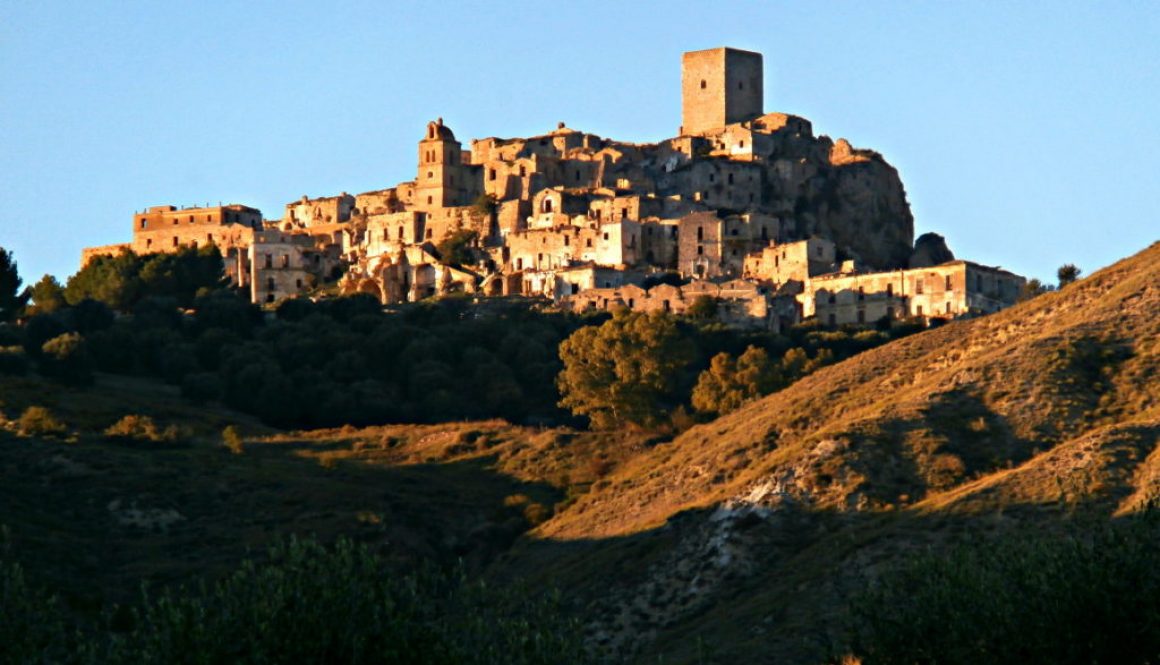CRACO – PART 1 OF EXPLORING BASILICATA WITH VIVIEN
4th October.
VIVIEN’S FIRST DAY TRIP
I’ll start with CRACO because I cannot remember the exact order of the trips we made with Vivien; so here goes, with apologies to Vivien if the dates don’t fit. CRACO had grabbed her interest when I sent her a download about it before our holiday started. Vivien is one of those people who do not like surprises; if we suggest somewhere we like for a meal she must Google it for every detail and all menus before she will try it. It seems that this careful research is applied to any and everything she is contemplating.
RUINS – ANCIENT AND MODERN
She is a highly qualified craftswoman, who maintains that she is far more interested in the history of things than she is of people, and so we were not surprised that first on her Basilicata bucket-list came the buildings of CRACO; not yet a UNESCO World Heritage site. although I’m sure that will come. However, it is on the list of The World’s Monuments Fund as very important.
Many were medieval; (some even earlier in this hilltop town with traces of iron-age occupation.) These, and all later builds, have been left deserted ever since a landslip in the 1950’s started the evacuation of residents – the last stubborn soul left in 1980. This was due to Craco being situated at the edge of the ‘badlands’, where no imported topsoil had been laid over the bare white sea of clay hills and cliffs.
THE GHOSTLY CITADEL GUARDING THE BADLANDS
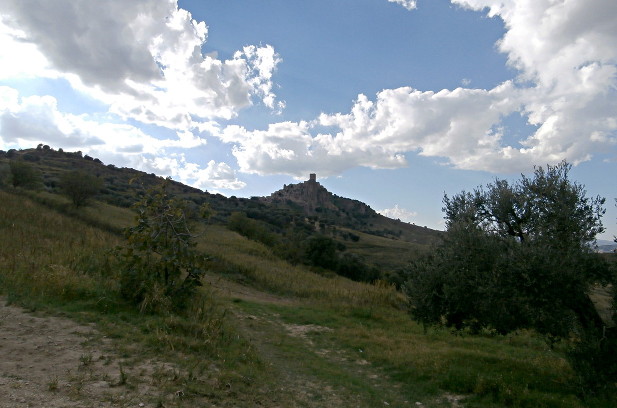
Craco took a little finding, as it is now well off the beaten track, but as we turned a bend in the country road there it was – an arresting sight; a ghost town of gaping windows and doors, very much like the unrestored part of Matera; only from our aspect we saw a very small town sitting atop a hill that was almost a perfect cone.
I AM LEFT BEHIND
We had to drive around the base of Craco to gain access to the reception building, where I had to stop, because the very nice guide said that attempting the ruined streets and many steps with my stick would be dangerous for me. The others were given hard hats and went off, while I found a booklet in English and was directed to a small theatre where for half-an-hour I watched a video about the doomed town. Fortunately, there was a vending machine selling water and chocolate, and the place had ample facilities, as my party returned a good 1hr 45 minutes later, to the all too obvious annoyance of the other staff, all itching to close the place and go home. However, Graham and Vivien were effusive in their thanks to the young guide who had been caught up in their intense interest and enthusiasm. http://www.cracomuseum.eu.com
(Here I’ll hand over to Graham to describe their experiences that afternoon:)
WE MEET WILLIAM – OUR CRACO GUIDE
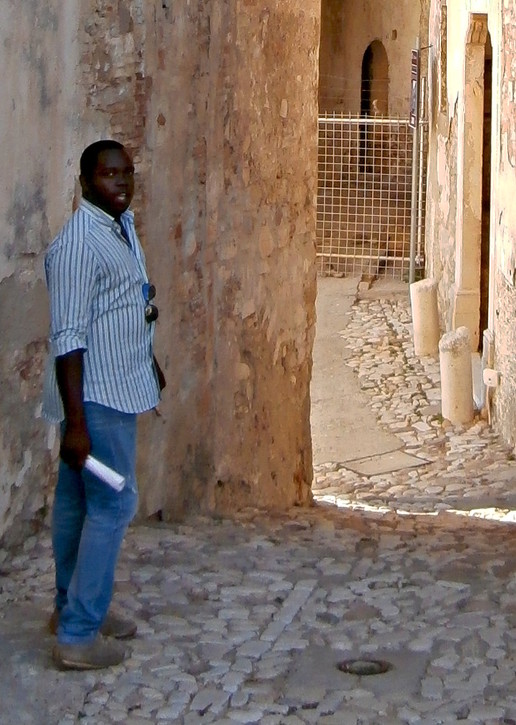
I can’t remember our guide’s name; I should have noted it down. He was a guy in his twenties from, I believe, Nigeria – and he had married a local girl. I think we got him because he spoke excellent English, and although we arrived rather late in the afternoon he didn’t hurry us; in fact, his enthusiasm for the crumbling town was infectious. For the sake of this post I’m going to call our super knowledgeable guide William – and hope he forgives me for forgetting his name and possibly getting his country of birth wrong.
First of all, you need to know that no one is allowed onto the Craco site without these official guides, and it is best, especially in the peak season, to look them up on the internet and contact them, as they tend to take parties. We were incredibly lucky that William was willing to take just the two of us when we turned up unannounced.
We followed him back in my car to the entrance gate.
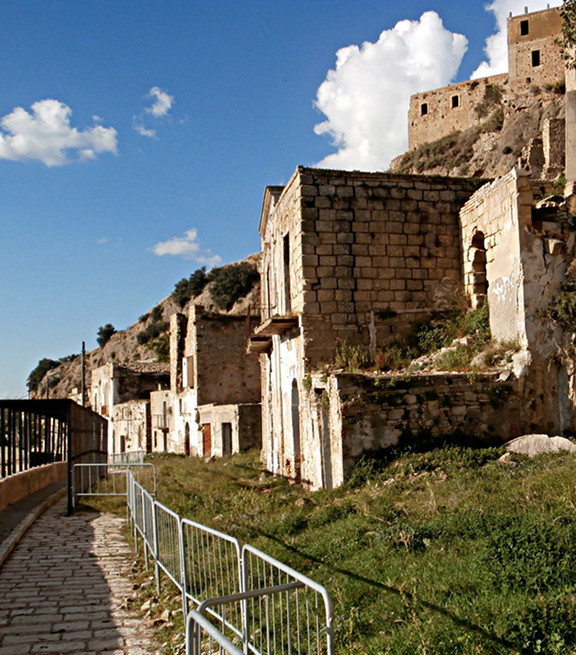
As we donned the hard hats and walked on marble setts along what was once the main thoroughfare into the town, William started to tell us about CRACO.
ANCIENT GREEKS AND ROMANS KNEW CRACO
The original settlement dated back to about the 8th cent BC, though the name Craco did not come into existence until 1260 AD.
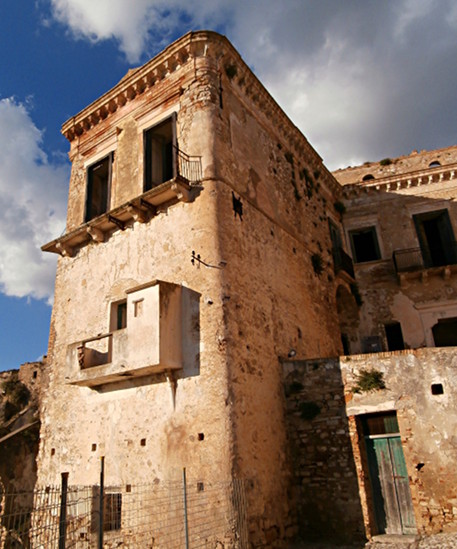
Right through it’s history it seems, Craco was a prosperous place, and at one time boasted an university. As we walked through the lower part of the town the signs of this prosperity still showed.
The downfall of the Medieval town actually didn’t start until the 20th century. William pointed up to the top of the site where most of the buildings were still intact. Two towers that looked to be in good condition dominated the buildings around them.
‘That is the oldest part of the town and in better repair and less vulnerable to landslides than the lower part, which we are walking through at the moment.’
He paused.
Like a good feed man I asked the question. ‘Why is that?’
WHEN CRACO SPREAD TO CLAY
‘The early part of the town was built on rock, but as Craco grew in the 17th, 18th, 19th and then 20th century, the only ground left was clay. This might have been okay, except that the town being one of the wealthiest around, the Council decided it needed to have a municipal drainage and sewerage works.
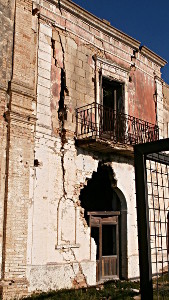
‘Then they had this beautiful road built.’ He whacked one of the setts with his pointing stick. ‘I should say the first development is responsible for the landslips, as this is a later addition, with better engineering. No one thought then about what would happen to all the water. That was the real start of their troubles. By 1963 people were being evacuated from the town and resettled lower in the valley. Then the flood of ’72’ really made the situation worse. After the earthquake of 1980 the town was completely abandoned. These days one shepherd and his goats graze the lower slopes.’
SAD SIGNS OF CRACO’S DEMISE
By the time he had finished his spiel on Craco’s downfall we had passed the open doorways and blank windows of gutted buildings that lined the street. One had a baker’s oven behind what had once been a shop, and on the front wall above it, rusted ornamental railings sagged near to collapse guarding what had been the owners’ living quarters. William pointed out various things as we passed other buildings; possessions the old owners had left, that told stories of their lifestyles.
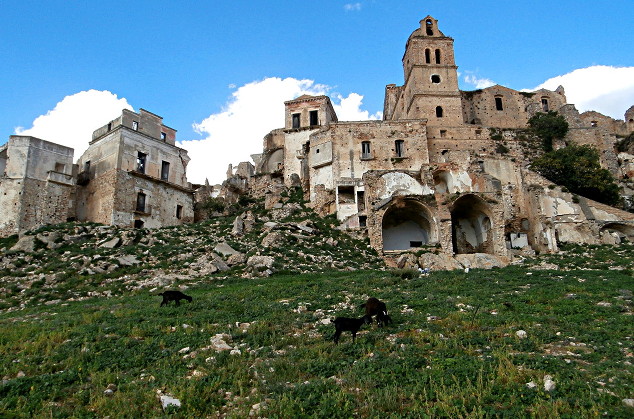
CRACKS IN CLAY SHOW CRACO’S DEVASTATION
We finally came to the end of the paved road. Before and above us was a large swathe of broken ground that had obviously had buildings on at one time. Now it was strewn with rubble as though a giant hand had swept down the hillside. Beyond this torn area buildings stood in ragged defiance; rooms open to the weather. Their outer walls had been wrenched away, leaving the side walls sagging. Some buildings had large cracks that reached from foundation to roof. I wondered how they could stay standing.
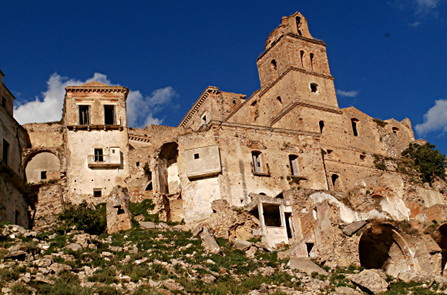
CRACO STILL CRACKING
We stood gazing in awe at the destruction. William gave us a lopsided smile and said, ‘This is why people are not allowed in here on their own. Many of the houses are very unsafe. We are trying to save as much as we can, but the ground here is always on the move, so we work on those built on rock.’
‘Surely they’re the older ones?’ Vivien piped up.
‘On the whole, yes; but earthquakes have caused a lot of damage to those, too.’
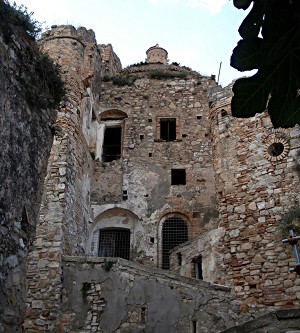
MEDIEVAL CRACO MORE INTACT
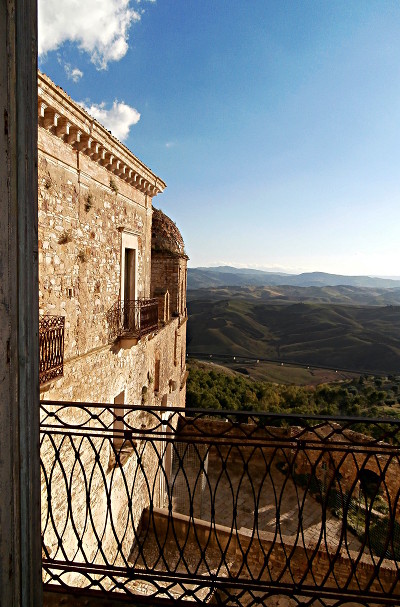
We skirted round the landslide to the track that would take us up into the higher town. In places it became steep and slippery with loose gravel, and I was glad Jackie had not come. I was quite breathless by the time I had scrabbled up the slope and William had let us through a corrugated fence that guarded the medieval part of the town.
Here the streets and houses of Craco took on a more recognizable style, with some of them in much better order, though we saw nothing I would call habitable.
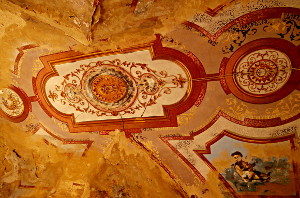
Even so, we found evidence of grand plazas with vistas out over the countryside, and ceiling decorations that no ordinary humble abode would have had.
As we went higher we would sometimes snatch a glimpse of the land spread out beyond, either through gaps between buildings, or sometimes, as we walked through interconnecting houses an empty framed window or doorway gave us a wondrous view onto the badlands beyond.
I wished we had arrived earlier, as I’m sure that William would have let us roam more. I can’t thank him enough for the experience. Do go and visit Craco and support the ongoing work in conservation that they are doing there. It is most impressive. They are stabilizing it more than trying to prettify, which I always think is for the best; leaving the thumbprint of the past to show through, and not clouding it with 21st Century sensibilities. I’ll finish this post with one more picture, to give you a better feel of the place. It is not an especially pretty view, more a majestic harshness taken from inside one of the buildings looking out into the badlands. (One of the feature pictures on our HOME page was taken of a domed roof looking out over the land.)

There are several so-called ‘Ghost towns’ (abandoned medieval villages) in Italy. You can Google the area you are planning to explore to see if there are any you can visit. There may be one or two that you can go around without a guide, so be aware that these places can be very unsafe. They were abandoned for a reason; mainly because of landslides or earthquakes, of which Italy has many. During the time we were travelling down through Italy there was a major incident which made us change our plans. So be very careful.
Text by – Jackie Usher, SWWJ. (aka author Debbie Darkin, & ‘Graham Liverpool’ on Trip Advisor.)
Photographs by – Graham Usher.
![]()

